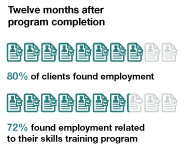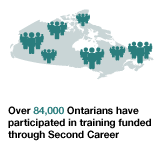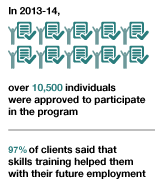ONTARIO
Second Career Program
PURPOSE: To provide laid-off, unemployed individuals with skills training to help them find employment in occupations with demonstrated labour market prospects in Ontario.
MINISTRY
Ministry of Training, Colleges and Universities, Government of Ontario
DESCRIPTION
The Second Career program provides up to $28,000 in financial assistance, based on individual need, to assist eligible and most suitable individuals with some of the costs associated with participating in skills training (e.g., tuition, books, transportation, and a basic living allowance).
Exempted allowances beyond the $28,000 cap may be available for disability accommodation, dependent care, living away from home and costs related to literacy and basic skills. For persons with disabilities, both literacy and basic skills and the skills training duration may be extended to meet the special needs of the individual.
Clients are expected to contribute towards the cost of their skills training program. The level of contribution is determined based on household income and family size.


RESULTS
As of December 31, 2014, over 84,000 Ontarians have participated in training funded through Second Career since the program’s inception in June 2008.
In 2013–14, over 10,500 individuals were approved to participate in the program and 97 percent of clients said that skills training helped them with their future employment.
Second Career clients are contacted at the completion of their skills training program, and again at three, six and twelve months after completion.
Follow-up results for 2014–15, as of December 31, 2014 show that 12 months after program completion, 80 percent of clients found employment and 72 percent found employment related to their skills training program.
According to an evaluation of the program, approximately 68 percent of participants who completed the program were, prior to training, employed in occupations that required less than a postsecondary credential.
Program participants have transitioned from jobs in fields such as retail into jobs such as truck drivers, accountants and early childhood educators. There is evidence that individuals who completed the Second Career program have moved into higher-growth industries. The program enhanced the employability of the participants for occupations that required relatively higher skills.
FURTHER INFORMATION










